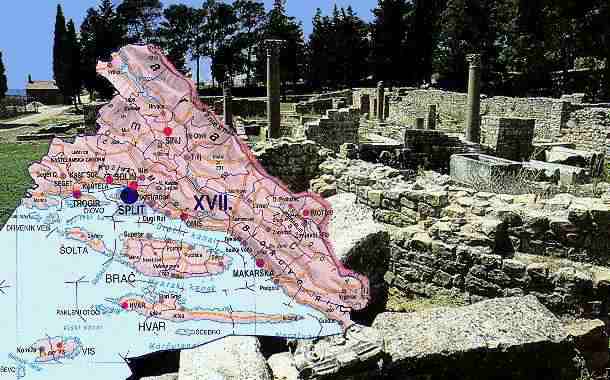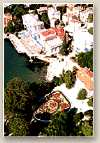|
site
map |
|
|
|
DALMATIA The territory of Dalmatia stretches southward from the Velika Paklenica Canyon, at the south end of Velebit. It has always been an inspiration for artists. Its coastal villages have resisted time and guarded the legacy of previous generations for posterity. Today, Dalmatia consists of four counties (12,000 square km.) and has a population of about one million.The northern part is flatland, followed by the hills of Ravni kotari. The impressive Dinara Mountain stretches across the river Zrmanja, and further south are the mountains Kozjak, Mosor and Biokovo, leading to the fertile Neretva River delta and the port of Ploče. Further again are Dubrovnik and the Prevlaka Peninsula. Dalmatia has the long Pelješac Peninsula and about 1000 islands, 55 of which are inhabited. There are several significant rivers: Zrmanja, Krka, Cetina, Jadro, Neretva and Ombla, but few lakes. The largest lake is Vransko, near Biograd. From a geological perspective, two lakes near Imotski, the Red and Blue Lakes, are of particular interest. The clarity of the Adriatic Sea is highest around the outer Dalmatian islands, where visibility can reach 56 meters. The climate is Mediterranean, with warm, bright summers and rainy winters. Numerous civilizations and cultures have occupied Dalmatia since times immemorial. The first were probably the Illyrians, whose small states were conquered by the Greek and Roman Empires. Greek urbanization began in places like Iader (Zadar), Narona (Vid, near Metković), Korkira Melaina (Korčula), Tragurion (Trogir), Epidaurum (Cavtat) and Issa (Vis). The name Dalmatia was first mentioned in the first century BC, probably as the Roman interpretation of the name of the Illyrian tribe in the region, the Delmati. Salona, present day Solin, was the capital of Roman Dalmatia. When Rome fell, Dalmatia was taken by the Eastern Goths, who later fell under Byzantine rule. After the Slav and Avar invasion, Dalmatia was incorporated into the Kingdom of Croatia. Venice took control of the region after the collapse of the kingdom, the renaissance Republic of Dubrovnik remaining a separate, independent entity. A serious of changes followed, with Napoleon’s conquest of Venice, the Austro-Hungarian Empire’s ascent to dominance in central Europe and the Turkish invasion of the Balkans all profoundly influencing Dalmatia and its people.
THE BIOGRAD RIVIERA Biograd, the former coronation site of medieval Croatian kings, today is a modern tourist resort and the centre of the Biograd Riviera. The town has excellent hotels, a holiday village, private accomodation and camps. A variety of restaurants, wine cellars, cafes, bars, bakeries, discos, cinemas and recreational facilities contribute to the endless possibilites available to the tourist. There are also modern shops and a medical center. Since Biograd is near the Kornati islands, it is an ideal harbour. Vransko Lake, only seven kilometers away, attracts sport fisherman. The Pašman Channel, with its many forested islets, is ideal for sailing. Hotels: Ilirija (B); Kornati (B); Adriatic (B); “Crvena luka” Hotel and Apartments (B) Camps: Crvena luka (II); Crkvine (II) Marina: Kornati - 500 moorings on floating docks, 200 on dry docks. Open all year. Sukošan Sukošan is a small harbor, eleven kilometers south of Zadar, located in a bay with sand beaches. The remains of Roman buildings are still visible. The parish church is from the 11th century, remodelled in the 17th century. Marina: Marina Zlatna Luka (The Golden Harbour) is the nautical center in the Zlatna Luka Bay, near Sukošan. It has 1200 moorings on floating docks for yachts no longer than 15 meters, and 600 moorings on dry docks (200 of which are covered). It is open all year. Sveti Filip i Jakov This village four kilometers north of Biograd has beautiful beaches. It was part of the Benedictine monastery in Rogovo. The monastery has a fortified abbey court with a church, cellar, oil production facility and salt-pan. It was destroyed in the war against the Turks. The present village was built after the Turks withdrew in the 18th century. Hotels: Mayica (C); “Croatia” Tourist Resort (B) Camps: Aardin (II) Pakoštane This village on the narrow isthmus separating Vransko Lake from the sea is six kilometers from Biograd. The remains of the ancient settlement near the sea are still visible, and the partial remains of Roman villa rustica were discovered near the graveyard. In the sea, the remains of the Roman breakwater are visible.
VODICE AND PRIMOŠTEN Vodice Vodice lies 13 kilometers north of Šibenik, beside a shallow bay. Beautiful beaches and quiet coves have been conducive to the development of tourism. The inhabitants of Vodice live off of agriculture, fishing and tourism. In a historical context, the settlement was first mentioned in 1402. In the 16th century it was fortified with walls and towers, only one of which remains. Hotels: Olympia (A); Imperial Hotel and Villas (B); Arausana (B); “Gloriette” Apartments (A); Punta (B) Camps: Imperial (II) Marina: ACI Vodice, seven nautical miles from Šibenik, 450 moorings on floating docks and 150 on dry docks, 10 and 40 ton cranes, parking lot Primošten The town of Primošten is located 28 kilometers south of Šibenik, on a tiny peninsula, connected to the mainland by a narrow causeway. The inhabitants live off of viticulture (as Primošten is famous for the Babić red wine), olive growing and fishing. There are large beaches, numerous hotels and great possibilities for underwater harpoon fishing. The name of the town comes from the Croatian verb, “premostiti,” meaning, “to bridge over,” because the island settlement, originally founded in the 16th century, was connected to the mainland by a bridge. The parish church of St. Juraj was reconstructed in 1760 and the church of Our Lady of Mercy was mentioned as far back as 1553. Hotels: Marina lućica (A); Zora/Slava (A); Raduča (B); Adriatic (A) Camps: Adriatic (II) Marina: Kremnik, in the cove near Primošten, only 30 miles from the Kornati Archipelago, 280 moorings on floating docks, 110 on dry docks, 5 ton crane and movable 40 ton crane, parking lot
TROGIR, KAŠTELA, SOLIN Trogir is a small town located at the end of Kaštela Bay, 27 kilometer north of Split. It lies on a small island between the larger island of Čiovo and the mainland, connected by drawbridge. In the third century BC, on the location of present day Trogir, the Greeks founded Tragurion, which developed into an important harbor. After the fall of the Roman Empire, refugees from Salona took shelter in Trogir. The old town was built between the 13th and 15th centuries, inside defense walls which were restored by the Venetians in the 15th century. They also added two forts which are have been preserved: the Kamerlengo Citadel and the Tower of St. Marko. The older, eastern part of the town grew around a main square and cathedral. The western part, known as Pašike, was built later. Trogir was once one of the foremost cultural havens of Dalmatia. In the 13th century master Radovan worked there. In the 15th century, the town was populated by famous sculptors, architects and historians. Entrance into town from the north is through the renaissance town gates, with the carving of St. Ivan Ursini, the patron saint of Trogir. On the main square is the cathedral from the 15th century, with characteristics of both Romanesque and Gothic styles. The most important and valuable work of Romanesque sculpture in Croatia is the portal of the cathedral, by master Radovan in 1240. The sculpture of St. Lovre and triangular gable were added in the 14th century. The chapel of St. Ivan Ursini is considered the most beautiful renaissance monument in Dalmatia. It was built in the 15th century by Nikola Firentinac. The early Gothic first floor of the belfry was finished in 1422 by Matej Gojković, and the final floor was built by Trifun Bokanić in late renaissance style. Trogir is a treasury of cultural and historical monuments, surrounded by the beauty of a Mediterranean landscape with an abundance tourist possibilities. Hotels: Medena (B); Jadran (B) Camps: Rožac (II); Belvedere (I); Medena (I); Seget (III) Marina: ACI Trogir, 200 moorings on floating docks and 50 on dry docks, reception, 10 ton crane, parking lot. Open year round. Kaštela This fertile 20 kilometer stretch between Split and Trogir is divided into two zones, Gornja (upper) and Donja (lower) Kaštela. It consists of seven old, and two relatively new, settlements. The region’s economy is based on vineyards, orchards and vegetable gardens, in addition to the industrial zone neighboring Split. The Split airport is located in Kaštela. The present area of Kaštela, along with Solin, were inhabited in ancient times. Seven settlements developed near the coast around castles built in the 15th and 16th centuries by nobility and clergy, hence the name, “Kaštel.” Those old settlements are Kaštel Štafilić, Kaštel Novi, Kaštel Stari, Kaštel Lukšić, Kaštel Kambelovac, Kaštel Gomilica and Kaštel Sućurac. Hotels: Palace (B) and Ilirija (C) in Kaštel Stari; Resnik Hotel and Apartments (B) in Kaštel Štafilić Camps: Porat and Resnik in Kaštel Štafilić; Mini Camp (II), Biluč Marica (II) and Biluč Josip (II) in Kaštel Stari. Solin Today, Solin is an industrial suburb of Split, five kilometers west of the city. It is divided in to three zones. Between Donja Strana (lower side) and central Solin are the remains of the Roman city of Salona, mentioned as far back as 119 BC as an Illyrian community, belonging to the Delmati tribe. After being conquered by the Romans, the emperor Augustus made it the economic and political center of Roman Dalmatia. It enjoyed its greatest prosperity under Emperor Diocletian, who built his summer palace on the nearby coast. Around 614 AD, Salona was taken by the Slavs and Avars. In the Middle Ages, it became a part of the Kingdom of Croatia. Among the Roman ruins preserved in Solin are the 2nd century AD auditorium, cemetaries, town square, several early temples and a 4th century basilica. The center of old Solin, built between the 4th and 6th centuries, includes the remains of a cathedral, baptistery, bishop’s palace and out-houses. To the east are the ruins of baths and an early Christian graveyard. The sarcophagi of Hipolit and Fedra, Iulia Aurelia and Hilae were found in the vicinity and are kept at the Archaeological Museum in Split. The remains of the sarcophagus of Queen Jelena, from 976, containing an inscription which is one of the most important documents from the early Croatian period, were found at the Marusinac cemetary. For details and you questions please contact as here |
|
|
Real
Estate Nekretnine, Split,
Croatia tel:
+356 79010337 Terms and Conditions | Privacy statement | info@nekretnine.org |

